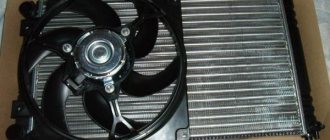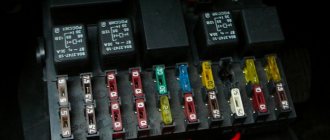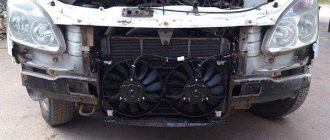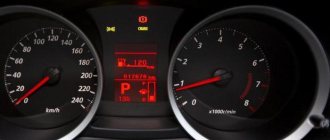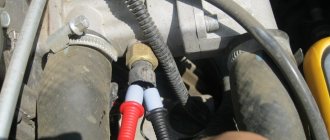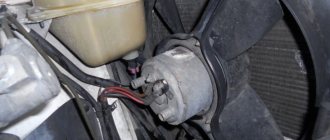There are many important components in a car, and the quality of the car as a whole depends on how well they work. One of these is the cooling system. It often happens on some models that the cooling fan is constantly running. This is not a very good sign. Insufficient engine cooling can lead to overheating of the engine - and this, in turn, can cost the owner a large sum of money for major repairs. But if you know the reasons for such operation in the cooling system, you can quickly identify where the fault is hidden and eliminate it. In order to find a breakdown, you do not need special knowledge and skills. Even a beginner can handle this. There are not many reasons why the cooling fan is constantly running.
The principle of operation of a fan in a cooling system
One of the reasons why a fan may run constantly or turn on frequently is due to the way the system operates. The fan starts at the command of a special sensor. It is located on the bottom of the radiator. This sensor is responsible for the coolant temperature indicators. If it is larger than needed, then the radiator fan will start.
When its blades rotate, additional airflow is created. It helps reduce the temperature of the coolant, which then passes through the passages in the engine. The cooling fan constantly works only on motors that for some reason overheat. To avoid serious problems, it is necessary to respond to this problem immediately.
I turn on the ignition and the cooling fan comes on.
Hi all. question for the experts. situation: after assembling (I didn’t assemble it myself) a 1.5L engine (07 my), when the ignition is turned on, the fan on the radiator of the cooling system starts working. where to look for the reason for the operation? what can you recommend?
I know one with similar symptoms (if you turn on the fans) it means the brain is working in emergency or service mode! When you start it does the check light come on? Is the speed sensor connected to the boxes?
When YOU are on SUBARU, YOU are obliged to help the one who is on SUBARU (if he needs it!!!)
Message from
e046ksI know one with similar symptoms (if you turn on the fans) it means the brain is working in emergency or service mode! When you start it does the check light come on? Is the speed sensor connected to the boxes?
I'll get some advice and go check everything tomorrow. )
It looks like either the coolant temperature sensor has failed, or they simply forgot to put the connector on it.
To understand, you have to drive!
or not all the chips were connected to the brains
Message from
VariagI'll get some advice and go check everything tomorrow. )
It’s clear, but you have only one path, to diagnostics!!! (the computer will tell you everything) It’s simple, it would seem. sensor, speed (but no, it affects the fans too) You didn’t say anything, you’ll see the car, the CHECK light is on???
When YOU are on SUBARU, YOU are obliged to help the one who is on SUBARU (if he needs it!!!)
And so this is EMERGENCY (service mode) 99.9%, just why did the brain come to it, that’s the question???
When YOU are on SUBARU, YOU are obliged to help the one who is on SUBARU (if he needs it!!!)
They just forgot to connect the temperature sensor. Located behind the generator, on top.
Message from
STROKERThey just forgot to connect the temperature sensor. Located behind the generator, on top.
That's why I don't care if the CHECK light is on when the engine is running!!!???
When YOU are on SUBARU, YOU are obliged to help the one who is on SUBARU (if he needs it!!!)
Message from
e046ksThat's why I don't care if the CHECK light is on when the engine is running!!!???
I'll write back tomorrow
The check is not lit, everything is connected.
Most likely, on the contrary, I got carried away with the assembly and stuck in EVERYTHING I could. Most likely I plugged in the fan diagnostic chip, GREEN BLOCK!!! It is located behind the front passenger sill trim (from the passenger compartment) - at least on Imprezas before 2007
UNDER THE STEERING WHEEL THERE IS A GREEN CHIP IF YOU CONNECT IT IT WILL WORK IN EMERGENCY MODE UNLOCK IT!!! THIS IS AN EMERGENCY FICTION
Such a malfunction can also occur if the fuel pump is not enough and the oxygen sensor shows an error for a lean mixture, then the fans work. All this is done so that the engine does not heat up when the mixture is lean...
If the check does not light up or blink (the lamp is working properly), then this is neither a test mode, nor a mixture error, etc. Guiding question - what does the temperature sensor on the dashboard show after warming up? The test-mode feature is not under the author’s steering wheel, but under the right front door sill trim.
check the fuses, I had this happen after an accident - the fan began to work constantly, they started looking at the electrics - several burnt fuses were found, replaced and everything went well, there seems to be some kind of protection there, if a fuse on one of the fans burns out, the second one starts working constantly
On my American car there is a left-hand drive feature under the steering wheel
Guys, thank you to everyone who took part in the discussion. In fact, I got carried away and connected the green chip (on my car it’s on the right, on the passenger side)
- You cannot create new topics
- You cannot reply to topics
- You cannot attach attachments
- You can not edit your posts
Your rights
Forum Rules
Thermostat
The engine may overheat due to the thermostat. It often happens that the mechanism of this element jams. The fan, in turn, necessarily reacts to this. The thermostat itself remains only half open.
As a result, the coolant cannot effectively remove heat from the engine as its movement through the system slows down. When the power unit overheats and the coolant temperature rises, the sensor reacts to this event and starts the fan. Owners of Opel Astra cars often encounter this problem - the cooling fan is constantly running. And the problem is solved by replacing the thermostat.
Operating principle and design features
Each type of fan has its own design nuances and operating principle. Let's look at each type in more detail:
1. Fan with viscous coupling. Such products are often found in models with a longitudinal installation of the power unit. At the same time, the systems are mounted, as a rule, on SUVs, and with the advent of electronics they began to gradually go out of use.
On the other hand, electronic devices are afraid of moisture, and the viscous coupling has maximum tightness and continues to work even after “bathing”.
2. Fan with ECU. Such systems consist of several structural elements - a temperature sensor, a power unit ECU and a fan relay. On modern cars, as many as two monitoring sensors are most often installed.
One is mounted directly in the pipe coming out of the radiator, and the second is installed at the outlet of the power unit. In this case, the thermostat is activated based on the difference in the readings of these devices.
In addition, on new VAZ models, other devices can take part in the fan control system, such as a crankshaft speed sensor and a flow meter.
In this case, all pulses are sent to the ECU, which, after analysis, gives a command to operate the device.
3. Fan with thermal switch. Old VAZ models did not have an electronic control unit, so the task of activating the device was assigned to a special thermal switch.
How to check the cooling system thermostat
Testing it is quite simple. To do this, you need to start the engine and warm it up to such temperatures when the valves of this mechanism operate. You can find out the temperature threshold directly on the device body. Usually it is 72 or 80 degrees. Then you need to check the temperature at the lower and upper pipes. If both are at approximately the same temperature, then the reason why the cooling fan is constantly running has been found. It is recommended to carefully inspect the thermostat valves after removing it. It is useless to repair this unit (it is easier and cheaper to buy a new one). By the way, if this element is dismantled, it can be checked without installing it in the car. To do this, the thermostat is placed in a container of water, which is then heated. Increasingly, the valve should open. If this does not happen, the device is faulty.
Cooling pump
Sometimes the reason why the cooling fan keeps running and won't turn off is the water pump. The temperature of the coolant in the radiator rises because its speed is slowed down. When liquid enters the cooling radiator, the antifreeze simply does not have time to cool to the required temperatures and passes to the next round. At the same time, the liquid heats up even more.
When the pump works somehow, the fan may indicate a problem. If the pump completely breaks down, then the engine will immediately boil - this is where serious problems and expensive repairs usually begin.
Cooling fan constantly running on Peugeot 308
Peugeot 308: fan turns on
Possible reasons for the Peugeot 308 cooling fan turning on
- A leaky oil filler neck, air entering the intake manifold or crankcase ventilation system, etc. – leakage of any component very often becomes the reason that the fan starts to work constantly
- Problems with the ignition system (coil leaks, faulty spark plugs) are usually accompanied by errors on the dashboard and an electric fan running non-stop.
- The need to flush the injectors and the fuel system as a whole is exactly how the officials advise treating the disease. It helps some, it doesn't help others.
- Malfunctions in the electrical circuit, such as poor ground, short circuit due to antifreeze or other liquid getting into the wiring, failure of the fan controller, as well as problems in the electronic control unit
- Problems in the exhaust system (oxygen sensor, catalyst) can also cause the fan to start turning on constantly. Usually all this is accompanied by increased fuel consumption.
The Peugeot 308 engine fan is constantly running - how to treat it?
Obviously, to identify the cause, it is necessary to carry out a number of diagnostic procedures and identify the root cause of why the fan constantly turns on and works. First of all, you need to do computer diagnostics and check the system for errors. Sometimes simply resetting them helps. In any case, during a comprehensive diagnostic process, the cause of the malfunction will become clear, and after it is eliminated, the fan should begin to operate stably and turn on when needed.
Our car service specializes in Peugeot repairs and we are ready in the shortest possible time not only to “diagnose” your Peugeot 308, but also to completely “cure” it. The cost of computer diagnostics at our Borovichok station is 600 rubles. Other useful articles:
Replacing the valve stem seals of the EP6 engine (Peugeot, Citroen)Replacing the timing chain on the Peugeot 308 (EP6) Flushing the radiator of the Peugeot 308 stove Peugeot 308 troit
Possible reasons for the Peugeot 308 cooling fan turning on
- A leaky oil filler neck, air entering the intake manifold or crankcase ventilation system, etc. – leakage of any component very often becomes the reason that the fan starts to work constantly
- Problems with the ignition system (coil leaks, faulty spark plugs) are usually accompanied by errors on the dashboard and an electric fan running non-stop.
- The need to flush the injectors and the fuel system as a whole is exactly how the officials advise treating the disease. It helps some, it doesn't help others.
- Malfunctions in the electrical circuit, such as poor ground, short circuit due to antifreeze or other liquid getting into the wiring, failure of the fan controller, as well as problems in the electronic control unit
- Problems in the exhaust system (oxygen sensor, catalyst) can also cause the fan to start turning on constantly. Usually all this is accompanied by increased fuel consumption.
This is only a part of the possible malfunctions in which the fan on the Peugeot 308 unnecessarily operates. We have omitted the obvious problems with the Peugeot cooling system, when the operation of the electric fan is absolutely justified: a failed thermostat, an antifreeze temperature sensor, a lack of coolant, an air lock - in general, everything that causes the unit to actually overheat and require cooling. In such cases, however, the fan does not turn on immediately after starting the engine, but only when the engine boils, so it is quite difficult to confuse these symptoms.
Lots of errors
The first thing that comes to mind when the fan does not turn off even in the cold at an antifreeze temperature of 50-60 degrees is a malfunction of the fan control unit, failure of the temperature sensors. The fan control relay on the Peugeot 308 is located behind the bumper. Yes Yes. To replace it you will have to remove the bumper.
On the German-French naturally aspirated engine EP6 there are already three of them - one sends readings to the instrument panel, the second gives an impulse to the ECU, the third is only responsible for starting the fan. However, the electronic engine control unit has the final say.
Therefore, any of the errors shown by the on-board computer (related to a breakdown of the ignition system, power supply, exhaust gas purification, exhaust gas recirculation, any electronic systems, variable valve timing system) leads to non-stop operation of the fan. Moreover, it works even after turning off the ignition for 5-7 minutes at second speed.
Sensor problems
Coolant temperature sensor.
The sensors themselves break down quite often, but at the same time they suffer from leaks.
In this case, the coolant can easily get onto the wiring harness, through it reach the ECU, and then the control unit could either short out completely and fail, or send incorrect commands to the actuators, or scare with non-existent errors.
As you can see, there are many reasons for a constantly running fan on a Peugeot 308 - any malfunction detected in the engine automatically leads to emergency operation , in which the fan constantly spins and does not think to turn off.
Why the fan on the Peugeot 308 does not turn off: the main reasons
If we move from simple to complex, then it would be more logical to build a chain of possible breakdowns from the fan itself and its controller, up to a firmware failure or replacement of the brains.
- Fan controller malfunction . If the fan spins not only at the second speed, but also at the first (when switching manually), most likely the controller is working. To gain access to the fuse and relay, you must remove the front bumper. The fan fuse has melted. Fan switch relay.
- The coolant temperature sensor has failed . Depending on the year of manufacture of the Peugeot 308, it could be either in the same housing with the thermostat or removed independently of it. Coolant temperature sensor
- Thermostat - it’s clear here: the engine is overheating (this can be easily determined by the readings of the sensor on the dashboard), so the fan tries to lower the temperature of the antifreeze. The thermostat, both pre-restyling and restyled, is checked according to the standard scheme. Restyling and pre-restyling thermostats.
- Inconstant mass on the engine . (This can be indicated at least by interruptions in the starter’s operation). It is necessary to check the engine ground contact and, if necessary, clean the oxide.
- Air leaks are one of the most common causes of this problem. Leaks can occur both in the intake manifold (after-throttle space) and in the crankcase ventilation system. Most often - the second case, and the problem occurs after dismantling and reinstalling the valve cover. Sometimes this happens even after an incorrectly installed oil filler cap or loss of the cap. The crankcase ventilation pipe may become disconnected or damaged, but the computer will not show any errors and the Check Engine lamp will not light up.
- The catalyst or lambda probe is faulty - in this case the computer will definitely give an error, in addition, high gasoline consumption will be observed. And the cause may be low-quality fuel.
- Problem in the ignition system : misfires, non-working spark plugs (depending on mileage). In this regard, one or more errors will also be displayed, the fan will run constantly. Faulty ignition coil.
Conclusion
It cannot be said that this is a complete set of reasons that cause inappropriate fan behavior, but in 90% of cases they are what lead to the problem. I wish everyone stable engine operation and smooth roads!
Pump faults
Often, the pump does not stop working suddenly. Initially, the pump gives various signals about breakdowns - for example, the engine cooling fan is constantly running or turns on frequently.
The main reason for pump failure is the bearing - it jams or collapses. You can tell that the pump has failed by the characteristic sounds coming from under the hood. They sound like some kind of howling or knocking. These sounds can be heard even at idle. Novice motorists often do not pay attention to these noises. Pump knocks are mistaken for camshaft malfunctions. To fix the problem, you need to replace the pump. Depending on the model, it is possible to install only the front part of the pump and replace the bearing.
Clogged cooling system channels
Often the engine overheats due to congestion in the cooling system. The situation is further complicated by the fact that diagnosing this problem can be quite difficult. Therefore, if the cooling fan constantly works or turns on more often than usual, it would not be superfluous to flush the SOD channels. In most cases, these activities are more than enough to ensure everything works correctly. Experts also recommend not limiting yourself to just flushing, but also additionally venting the radiator.
DVV
Sensors turn on
The fan switching sensor (FSW) occupies not the last place in the internal combustion engine cooling system. He is responsible for engaging the fans installed on the radiator and activated when the coolant temperature increases and standard cooling for the engine is clearly not enough.
If the DVV is connected directly to the ignition, and not to the relay, then it is recommended to carry out a different circuit by replacing the sensor. A sensor connected directly to the ignition may not work correctly. On some car models it is integrated with a relay, which looks noticeably more reliable.
The diagram looks like this in this case:
- The minus of the fan is connected directly from the battery, the plus - from the battery through a relay (it is also possible to connect the plus directly from the ignition);
- The sensor is also integrated with the relay on one side, and with the ground (any part of the car body) on the other.
Obviously, if the sensor is responsible for turning on the fan on the car, then untimely activation of the system may well be caused by damage to the element. Let's look at what the sensor consists of.
Both fans turn on when the ignition is turned on
Its device is simple. A bimetallic strip is installed at the bottom of the sensor. It is made so that when the coolant temperature increases, it deforms and thereby affects the contacts of the device.
Regarding the sensor connection circuit:
- Until the coolant heats up, the sensor plate is level and does not move;
- As soon as the coolant temperature increases (reaches a certain level), the plate is deformed and the contacts close.
It is noteworthy that on different car models the DVVs are set to one or another activation temperature.
There are two types of DVVs: those designed for 1 rotation speed and models designed for 2 rotation speeds.
The fan runs when the ignition is turned on.
As a rule, all modern cars are equipped with DVV with a 1-speed activation system, although 2-speed sensors are not uncommon. It will be interesting to note that on such a DVV, when a certain degree level is reached, the fan turns on to the first rotation speed. The second speed is activated and the fan speed increases accordingly when the coolant temperature continues to rise.
Damage to the engine is not only problems when turning on the ignition, but also overheating of the engine and other unpleasant moments. For this reason, first of all, if the fan turns on when you turn on the ignition, you should test the functionality of the sensor.
You can test the functioning of the DVV yourself. To do this, you need to hang the removed sensor over a pan filled with water. Connect the DVV in advance with two wires to a continuity tester (multimeter).
Attention. The metal part of the DVV should be immersed in water. In addition, the sensor should not come into direct contact with the pan.
The DVV should be triggered when the water in the pan heats up. It is recommended to study the technical specifications of the DVV in advance in order to properly test the sensor. For example, some of them are designed to turn on after 93 degrees Celsius, others - after 100 degrees, etc.
How to clean the cooling system
When cleaning the channels of the cooling system and radiator, the antifreeze is also replaced. To perform flushing, the old antifreeze must be drained. Then a fairly strong solution based on citric acid is poured into the system. This is an effective folk remedy, but there are also various liquids with additives.
After this, start the engine - so the car should run for 30 minutes. This is enough to thoroughly clean all channels. Then you can turn off the engine, drain the cleaning mixture, and finally add fresh antifreeze. Often in this way it is possible to completely solve problems in the operation of the cooling system if the reasons are contamination.
How to flush a radiator
To correct the situation and protect the motor from harmful overheating, it is recommended to clean the element. On most modern cars, the part must first be dismantled, but cleaning can often be done without dismantling.
Experts recommend cleaning with ordinary water. It is best if it is supplied through a hose. Sometimes it makes sense to clean the radiator cells with a brush and only then flush them. Often this procedure is combined with blowing the radiator with compressed air.
Air locks in the cooling system
For experienced car owners, air locks are not a secret at all. They arise due to some errors during the process of replacing the coolant. Leaks in the system are also the cause. Antifreeze cannot warm up evenly. This leads to instability in the fan operation. It often turns on or even works without interruption - hot coolant enters the radiator. Before you try to eliminate these same traffic jams, you need to check the system for leaks. If they are found, then they should be eliminated. Next you need to remove the plugs. For this you need a compressor. One tube is unscrewed from the throttle, which supplies fluid. Then a compressor is connected to the neck of the expansion tank and the air supply begins. Two to three minutes will be enough for all traffic jams to go away.
Problems with the temperature sensor
If the cooling fan on a VAZ 2107 is constantly running, then the radiator temperature sensor on both carburetor and injection cars is often to blame. In most cases, it is simply in a closed state.
If these are the symptoms, then check the time for which the fan turns on and compare the temperature when it turns on with the standard one. If the indicators are lower, then the problem is easily solved by replacing the sensor.
The engine fan turns on frequently - reasons
In the case of the Chevrolet Aveo 1.2 ECOTEC 86 HP, presented for the incorrect operation of its fan, corresponded to a simple and easy fix. Therefore, the owner of the vehicle can talk about great luck. It happens that a faulty fan module . And this, unfortunately, comes with a definitely higher cost of repair! The module is an integral part of the fan, and if it fails, the entire fan is replaced! In the case of the presented Aveo, this means costs of 30,000 rubles for the original part! And although this seems like a huge amount, compared to a fan for a BMW 520d E60, it costs up to 48,000 rubles at the dealership!
The engine fan turns on frequently - reasons
However, if we look for substitutes, we can clearly reduce this cost. POLCAR's offer includes a good replacement for the Aveo fan for 6,000 rubles (with housing). This means almost 5 times the difference in cost! It is not surprising that buyers very rarely decide to purchase an original part for this type of repair.
Summarize
So, among the most popular reasons why a fan is unstable are problems with electronics. This is exactly what most car owners complain about on specialized forums. Many solve this problem by replacing the sensor and fuses. And it helps. In half of the cases, the issue can be resolved by replacing the thermostat. The situation can also be improved by cleaning the radiator.
Problems happen on any car; this topic worries Ford Focus car owners. The cooling fan runs constantly on luxury cars as well. It is important to notice this problem in time, otherwise it can lead to disastrous consequences. In case of severe overheating, the engine can only be helped by a major overhaul with the replacement of the cylinder head, cylinders, pistons and other components.
When is it advisable to repair it yourself and in the service?
If your car has problems with the electric fan of the cooling system, you can fix the problem in the sequence described above. Almost any repair can be done by yourself. Since the main problems come down to faulty sensors, replacing them will not be difficult. It is enough to dismantle the faulty part and install a new one in its place. If the problem lies in bad contacts, then they can be cleaned or, as a last resort, the connectors can be replaced. If you are not confident in your abilities, then in order to avoid new problems it is better to contact the service.
Video: solving the problem of a constantly running fan
To decide whether to carry out independent repairs in case of problems with the cooling fan or seek outside help, you can familiarize yourself with the approximate prices for a particular operation.
Table: cost of repairing the cooling system with your own hands and in the service
| Name | Approximate cost, rub. | |
| On one's own | In service | |
| Replacing the Fan Sensor | from 150 | from 500 |
| Checking coolant leaks | for free | from 500 |
| Checking the coolant level | for free | from 500 |
| Replacing the cooling fan | from 500 | 500–1000 |
| Minor wiring repairs | for free | 200–500 |
| Radiator cleaning | for free | From 800 |
| Replacing the thermostat | from 350 | From 800 |
Constant rotation of the cooling fan on a cold engine is not normal. Therefore, you should deal with the malfunction that has arisen, find and eliminate the cause of its occurrence in order to prevent rapid wear of the device. Diagnostics consists of checking the coolant level, as well as the elements responsible for the operation of the electric fan, which every car owner can do.
